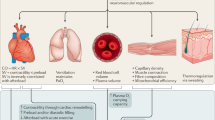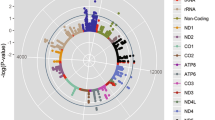Abstract
Angiotensin-converting enzyme in human skeletal muscle1 can be encoded by either of two variants of the ACE gene2, one of which carries an insertion of 287 base pairs. This longer allele gives rise to lower enzyme activity2, and is associated with enhanced endurance performance3 and an anabolic response to intense exercise training4. Here we examine training-related changes in the mechanical efficiency of human skeletal muscle (energy used per unit power output) and find that the presence of this ACE allele confers an enhanced mechanical efficiency in trained muscle.
Similar content being viewed by others
Main
Subjects and staff were blind to genotype during experimentation and data analysis; genotypes are represented as ‘I’ for the ACE allele carrying the 287-base-pair insertion, and ‘D’ for the allele that does not. Caucasian army recruits (58 men: 35 II and 23 DD) were studied before and after an 11-week programme of (primarily aerobic) physical training. Subjects pedalled on a bicycle ergometer at a constant 60 r.p.m. for 3 min at each of three successive external power outputs (40, 60 and 80 W). Steady-state oxygen uptake (VO2 in ml min−1) and the respiratory exchange ratio were measured and used to calculate the energy expended per minute at each stage.
The delta efficiency (percentage ratio of the change in work performed per min to the change in energy expended per min), which represents the efficiency of muscular contraction5, was calculated. We assessed changes in delta efficiency with training by using paired t-tests, and comparisons were made between genotype groups by independent t-test. Values of P<0.05 were considered statistically significant.
Before training, the delta efficiency was independent of genotype (24.5 and 24.9% respectively, P=0.59), but the response to training was strongly genotype-dependent, with delta efficiency rising significantly only among those of II genotype (absolute change of −0.26% for those of DD genotype (P>0.05) and 1.87% for those of II genotype (P<0.01): P<0.025 for II compared with DD; changes were independent of all pretraining characteristics (Fig. 1)). These differences represent a proportional increase in efficiency of 8.62% relative to baseline for those of II genotype and −0.39% for DD, which may have more biological impact than this value would suggest6.
ACE genotype was determined in 579 male army recruits as before15. At entry, 108 randomly selected homozyotes (59 II, 49 DD) exercised on an electronically braked cycle ergometer (Lode Rehcor, Netherlands) at 60 r.p.m. At external power outputs of 40, 60 and 80 watts (3-min stages), the rate of energy expenditure (in watts) was calculated from oxygen uptake (ml min−1) and respiratory exchange ratio (Cardiokinetics metabolic measurement cart, Medical Graphics Corp.)16. After an 11-week training period, 58 subjects (35 II: 19.4±0.3 yr, 1.78±0.01 m, 71.3±1.2 kg: all baseline characteristics independent of genotype) were retested. Those completing the study did not differ in any measured respect from those who did not. Asterisk, P<0.025. This study was approved by the appropriate ethics committee and written, informed consent was obtained from each participant.
We do not know how the II genotype helps to improve the mechanical efficiency of trained muscle, but it may be related to an increase in slow-twitch rather than fast-twitch muscle fibres, which are more efficient in slow contraction7. The lower ACE enzyme activity associated with the II genotype may also raise local concentrations of nitric oxide, which in turn may improve the efficiency of mitochondrial respiration and hence contractile function in both cardiac and skeletal muscle8. The number of mitochondrial uncoupling proteins in skeletal and cardiac muscle drops during endurance exercise training9, and this reduction might be ACE-genotype dependent.
Our results have implications beyond sporting activity. The mechanical and metabolic efficiency of skeletal muscle is increased in situations in which achieving more external work for less energy utilization might be advantageous (such as lactation10 and dietary-induced energy deficiency11). Congestive heart failure, for example12, interferes with the delivery of oxygen and metabolic substrates to the whole body, so improved skeletal muscle mechanical efficiency would be beneficial. During a heart attack, the limited blood supply to the myocardium means that there is a sudden drop in the uptake of metabolic substrates and oxygen, when enhanced cardiac muscle metabolic efficiency would be an advantage.
Such benefits could be associated with lower ACE activity, an idea that may partly explain the beneficial effects of ACE inhibitors on myocardial cell survival during ischaemia13 and on the survival of patients with cardiac dysfunction14.
References
Dragovic, T. et al. Diabetes (suppl. 1) 34–37 (1996).
Danser, A. H. et al. Circulation 92, 1387–1388 (1995).
Montgomery, H. E. et al. Nature 393, 221–222 (1998).
Montgomery, H. et al. Lancet 353, 541–545 (1999).
Gaesser, G. A. & Brooks, G. A. J. Appl. Physiol. 38, 1132–1139 (1975).
Conley, D. L. & Krahenbuhl, G. S. Med. Sci. Sports Exerc. 12, 357–360 (1980).
Coyle, E. F., Sidossis, L. S., Horowitz, J. F. & Beltz, J. D. Med. Sci. Sports. Exerc. 24, 782–788 (1992).
Zhao, G., Bernstein, R. D. & Hintze, T. H. Coron. Art. Dis. 10, 315–320 (1999).
Boss, O. et al. FASEB J. 12, 335–339 (1998).
Spurr, G. B., Dufour, D. L. & Reina, J. C. Eur. J. Clin. Nutr. 52, 17–21 (1998).
Kulkarni, R. N. & Shetty, P. S. Ann. Hum. Biol. 19, 421–425 (1992).
Kemp, G. J. et al. Heart 76, 35–41 (1996).
Morris, S. D. & Yellon, D. M. J. Am. Coll. Cardiol. 29, 1599–1606 (1997).
AIRE Study Investigators Lancet 342, 821–828 (1993).
Montgomery, H. E. et al. Circulation 96, 741–747 (1997).
McArdle, W. D., Katch, F. I. & Katch, V. L. Exercise Physiology: Energy, Nutrition and Human Performance (Lea & Febiger, London, 1991).
Author information
Authors and Affiliations
Corresponding author
Rights and permissions
About this article
Cite this article
Williams, A., Rayson, M., Jubb, M. et al. The ACE gene and muscle performance. Nature 403, 614 (2000). https://doi.org/10.1038/35001141
Issue Date:
DOI: https://doi.org/10.1038/35001141
This article is cited by
-
The angiotensin-converting enzyme I/D polymorphism does not impact training-induced adaptations in exercise capacity in patients with stable coronary artery disease
Scientific Reports (2023)
-
Robust arm and leg muscle adaptation to training despite ACE inhibition: a randomized placebo-controlled trial
European Journal of Applied Physiology (2023)
-
Evaluation of the soldier's physical fitness test results (strength endurance) ın relation to genotype: longitudinal study
Egyptian Journal of Medical Human Genetics (2022)
-
Respiratory muscle function in the newborn: a narrative review
Pediatric Research (2022)
-
Angiotensin-converting enzyme (ACE) insertion/deletion gene polymorphism across ethnicity: a narrative review of performance gene
Sport Sciences for Health (2021)
Comments
By submitting a comment you agree to abide by our Terms and Community Guidelines. If you find something abusive or that does not comply with our terms or guidelines please flag it as inappropriate.




